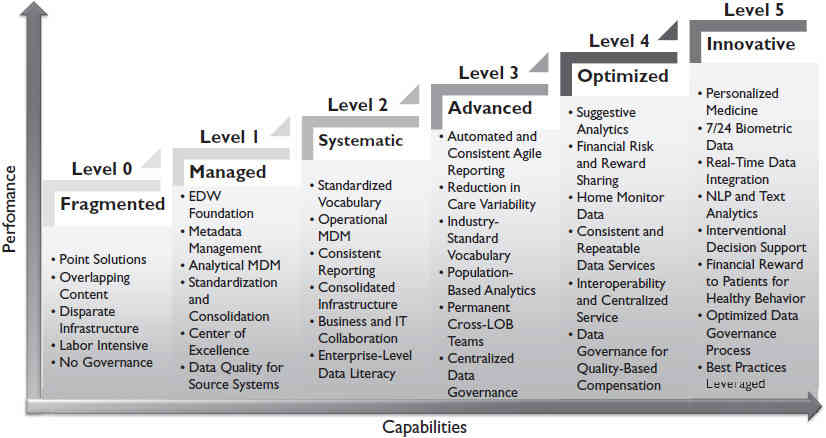 Most healthcare organizations are faced with disparate data sources, including electronic medical records (EMRs) such as patient records, procedures, medica tions, and labs; departmental research databases; clinical data warehouses; medical ontology; and significant unutilized, unstructured content, including doctor’s notes, tests, and results summaries. Their analytical requirements range from measuring required key performance indicators (KPIs), including readmission rates, mortality rates, hospital-acquired infections, and surgical care improvement, to answering new questions such as the following: What does our patient population look like? What is the geographical distribution of patients and clinics? Where are we using high-cost medications? Are there correlations with procedures and nursing facilities for re-admission?
Most healthcare organizations are faced with disparate data sources, including electronic medical records (EMRs) such as patient records, procedures, medica tions, and labs; departmental research databases; clinical data warehouses; medical ontology; and significant unutilized, unstructured content, including doctor’s notes, tests, and results summaries. Their analytical requirements range from measuring required key performance indicators (KPIs), including readmission rates, mortality rates, hospital-acquired infections, and surgical care improvement, to answering new questions such as the following: What does our patient population look like? What is the geographical distribution of patients and clinics? Where are we using high-cost medications? Are there correlations with procedures and nursing facilities for re-admission?
It’s a long journey, and it takes continuous improvement to become an analytics-driven organization. Many healthcare organizations are at different stages in terms of their analytical capabilities. Their requirements and business priorities will also play a role in determining what capabilities are needed and how to lay out a strategic road map. To put things in context, let’s first take a look at the Healthcare Analytics Capability Maturity Model, including the different stages of analytical capabilities, as well as the characteristics of these stages.
Healthcare Analytics Capability Maturity Model
The Healthcare Analytics Capability Maturity Model (HACMM) can be categorized into the following six stages:
- Level 0: Fragmented
- Level 1: Managed
- Level 2: Systematic
- Level 3: Advanced
- Level 4: Optimized
- Level 5: Innovative
Figure 1 is a visual representation of this maturity model.

FIGURE 1. The Healthcare Analytics Capability Maturity Model (HACMM)
In the next section, we’ll describe each of these stages through the following angles: definition, characteristics, incorporation of data sources, architecture, infrastructure, and people and skills, as well as state of governance.
Level 0: Fragmented
Definition:
- Level 0 is defined by fragmented point solutions with inefficient and inconsistent versions of the truth.
Characteristics:
- The main characteristic of this stage is the multitude of vendor-based and internally developed applications that are used to address specific analytic needs as they arise.
Data Sources:
- Overlapping data content leads to multiple versions of analytic truth.
Architecture:
- The fragmented point solutions are neither colocated in a data warehouse nor architecturally integrated with one another.
Infrastructure:
- Technologies and tools are informal and not standardized. Decisions are heavily influenced by project team and/or technology-savvy individuals, instead of based on a set of commonly agreed upon guiding principles.
Organization and People:
- Reports are labor intensive and inconsistent.
- Analysts spend the majority of their time assembling reports and cross-checking numbers to avoid mistakes and correct data quality issues manually.
- Analytical skills are spread throughout different parts of the organization. Skill levels are inconsistent. The sharing of expertise and best practices is rare and ad hoc.
Governance:
- Data governance is limited or nonexistent.
- Analytical and data standards do not exist.
Level 1: Managed
Definition:
- Level 1 is identified by the existence of an enterprise data warehouse as the foundation of data and technology.
Characteristics:
- A searchable metadata repository is available across the enterprise.
- The data warehouse is updated within one month of source system changes.
Data Sources:
- The data (including EMR data, revenue cycle, and financial data) is colocated in a single data warehouse.
- Data content might include insurance claims.
Architecture:
- Analytical master data capabilities are established for patient indexes, facilities, and providers.
- The main focus of integration capability is ETL tools for enterprise data warehouse data loading needs.
- Metadata is managed through the combination of data dictionary of the data warehouse and ETL tool repository, as well as the BI metadata repository.
Infrastructure:
- The organization has started to set enterprise-wide standards for information management technologies.
- The IT organization starts to look into the consolidation and optimization of technology portfolios around business intelligence, data warehouse, and integration tools.
Organization and People:
- The enterprise data warehouse team reports organizationally to the global CIO instead of regional or lines of business IT.
- A BI Center of Excellence starts to form in some organizations and crosses lines of businesses to share best practices and establish standards.
Governance:
- Data governance is forming around the data quality of source systems.
- Functional data stewardship is taking shape.
Level 2: Systematic
Definition:
- Level 2 is defined by a standardized vocabulary across the enterprise, and patient registries move from analytical only to focus on the operational level.
Characteristics:
- A master vocabulary with reference data is identified and standardized across disparate source system content in the data warehouse.
- Naming, definitions, and data types are consistent with local standards.
Data Sources:
- Patient registries are defined and integrated at the operational level.
- Additional data sources are incorporated into the enterprise data warehouse, including the costing model, supply chain information, and patient experience.
Architecture:
- The analytic objective is focused on consistent and efficient production of reports supporting basic management and operations of the healthcare organization.
- Key performance indicators are easily accessible from the executive level to the frontline managers and knowledge workers.
Infrastructure:
- Information management technology services are optimized and consolidated with other infrastructure and application technology services into enterprise-wide, holistic, and integrated enabling services.
Organization and People:
- Corporate and business unit data analysts meet regularly to collaborate and prioritize new features for the enterprise data warehouse.
Governance:
- Data governance forms around the definition and evolution of patient registries and other master data management including providers, facilities, and employees.
- Data governance expands to raise the data literacy of the organization and develop a data acquisition strategy for additional data sources.
Level 3: Advanced
Definition:
- Level 3 is defined by automated external reporting with efficient, consistent, and agile production.
Characteristics:
- The main characteristic of this level is manifested in the reduction of waste and patient care variability.
- Analytical objectives include measuring and managing evidence-based care and clinical effectiveness.
- There is more focus toward consistent and efficient production of reports required for regulatory and accreditation requirements, payer incentives, and specialty society databases with adherence to industry-standard vocabularies.
- Population-based analytics are used to suggest improvements to individual patient care.
Data Sources:
- Clinical text data content is available for simple keyword searches.
- The precision of registries is improved by including data from lab, pharmacy, and clinical observations in the definition of the patient cohorts.
- Data content expands to include insurance claims (if not already included) and health insurance exchange data feeds.
Architecture:
- Enterprise data warehouse content is organized into evidence-based and standardized data marts that combine clinical and cost data associated with patient registries.
- On average, the enterprise data warehouse is updated within one day of source system changes.
Infrastructure:
- There is integration with existing systems across LOBs, virtualization, and user-centric tools.
Organization and People:
- Permanent multidisciplinary teams are in place that continuously monitor opportunities to improve quality as well as reduce risk and cost across different business processes, including acute-care processes, chronic diseases, patient safety scenarios, and other internal workflows.
Governance:
- Centralized data governance exists for the review and approval of externally released data.
- Data governance expands to support care management teams that are focused on improving the health of patient populations.
Level 4: Optimized
Definition:
- The key marker for level 4 of healthcare analytical maturity is population health management and suggestive analytics to improve clinical risk intervention.
Characteristics:
- The accountable-care organization shares in the financial risk and reward that is tied to clinical outcomes.
- Analytics data is available at the point of care to support the objectives of maximizing the quality of individual patient care, population management, and the economics of care.
- Analytic focus expands to address the diagnosis-based and fixed-fee per-capita reimbursement models.
- Patients are flagged in registries who are unable or unwilling to participate in care protocols.
Data Sources:
- Data content expands to include bedside devices, external pharmacy data, and detailed activity-based costing.
- Data content expands to include home monitoring data, long-term care facility data, and protocol-specific patient-reported outcomes.
Architecture:
- On average, the enterprise data warehouse is updated multiple times per day as the source system data changes.
- Data services are defined, built, managed, and published to provide consistent service-based data management capabilities.
Infrastructure:
- Infrastructure capabilities focus on interoperability and service-oriented architecture.
- There is a balance of centralized services versus local autonomy to achieve an economy of scale and agility.
Organization and People:
- The enterprise data warehouse and analytical teams report organizationally to a C-level executive who is accountable for balancing the cost of care with the quality of care.
Governance:
- Data governance plays a major role in the accuracy of metrics supporting quality-based compensation plans for clinicians and executives.
Level 5: Innovative
Definition:
- Level 5 of the analytical maturity model is defined in terms of healthcare advances in personalized medicine with mature and governed prescriptive analytics capabilities.
Characteristics:
- Analytic objectives expand to wellness management, physical and behavioral functional health, and mass customization of care.
Data Sources:
- Data content expands to include 24/7 biometrics data, genomic data, and familial data.
Architecture:
- Analytics expands to include the natural language processing (NLP) of text, prescriptive analytics, and interventional decision support.
- Prescriptive analytics are available at the point of care to improve patient-specific outcomes based upon population outcomes.
- The enterprise data warehouse is updated in real time to reflect changes in the source systems.
Infrastructure:
- The information architecture group actively reviews, evaluates technology trends, and jointly works with the business to adopt new technologies and tools in evaluating the effectiveness of initiatives such as creating new business models and driving new business capabilities.
Organization and People:
- Physicians, hospitals, employers, payers, and patients collaborate to share risk and reward (for example, financial reward to patients for healthy behavior).
Governance:
- Governance councils, information owners, and data stewards have optimized processes in resolving problems pertaining to cross-functional information management issues.
- Best practices are identified, documented, and communicated.
- The information architecture team ensures that these best practices are extended across the enterprise through reference architecture development and sharing, as well as architecture review activities.


